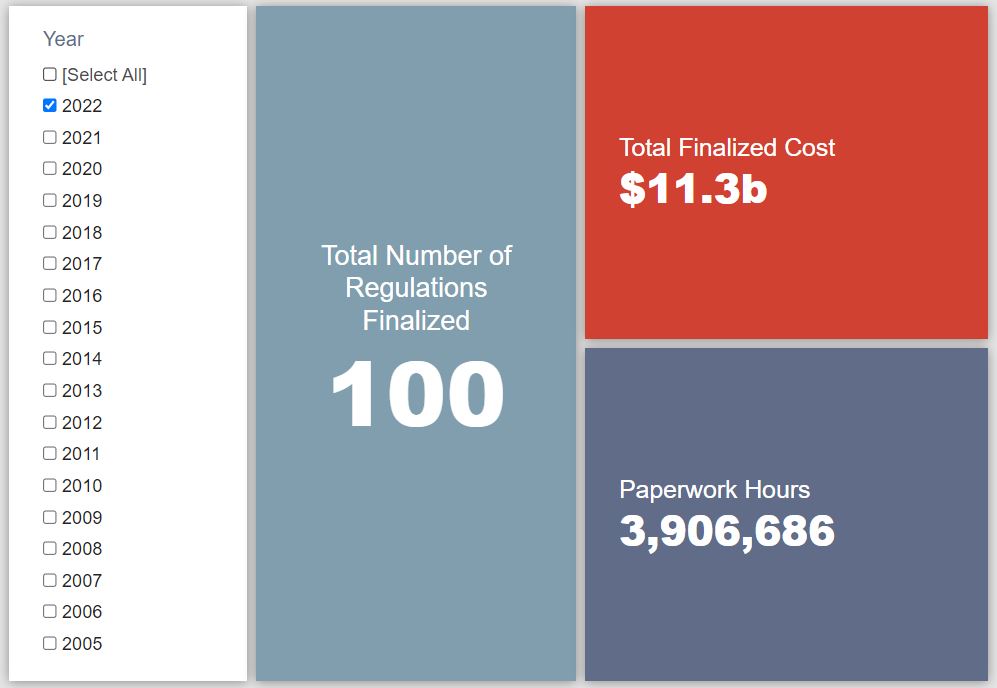Week in Regulation
May 31, 2022
Administrative Dusk
This past week was, for the most part, a relatively quiet one on the regulatory front. If anything, it was jam-packed with … administrative housekeeping. The two marquee rulemakings focused on such exhilarating topics as internal agency retrospective review procedure and financial reporting for multi-employer pension funds. Across all rulemakings, agencies published $396.4 million in total net cost savings but added 1.4 million annual paperwork burden hours.
REGULATORY TOPLINES
- Proposed Rules: 40
- Final Rules: 66
- 2022 Total Pages: 32,241
- 2022 Final Rule Costs: $11.3 billion
- 2022 Proposed Rule Costs: $75 billion
NOTABLE REGULATORY ACTIONS
The most consequential rulemaking of the week was the Department of Health & Human Services (HHS) formal withdrawal of the Securing Updated and Necessary Statutory Evaluations Timely (SUNSET) rule. This action closes the book on the Trump-era policy that would have installed a more rigorous retrospective review process in HHS. The fuller implications of this withdrawal are the topic of This Week’s Regulatory Picture, below. In terms of purely quantifiable economic impact, the current Biden-era HHS estimates that removing the Trump-era rule from the books would lead to total cost savings to the public of between $201-$603 million – with a mid-point estimate of approximately $402 million.
The other notable item of the week was a multi-agency rule (from the Internal Revenue Service, Employee Benefits Security Administration, and Pension Benefit Guaranty Corporation; or “the agencies”) updating aspects of Form 5500, “Annual Return/Report of Employee Benefit Plan.” This reporting requirement “serves as the principal source of information and data … concerning the operations, funding, and investments” of pension funds under each of the agencies’ respective purviews. While the quantified change in costs is relatively minimal, the agencies anticipate that such adjustments could impose roughly 1 million hours of additional paperwork burdens each year.
TRACKING THE ADMINISTRATIONS
As we have already seen from executive orders and memos, the Biden Administration will surely provide plenty of contrasts with the Trump Administration on the regulatory front. And while there is a general expectation that the current administration will seek to broadly restore Obama-esque regulatory actions, there will also be areas where it charts its own course. Since the AAF RegRodeo data extend back to 2005, it is possible to provide weekly updates on how the top-level trends of President Biden’s regulatory record track with those of his two most recent predecessors. The following table provides the cumulative totals of final rules containing some quantified economic impact from each administration through this point in their respective terms.
![]()
The two rules highlighted above were the respective sources in the Biden Administration’s cost and paperwork shifts, with costs decreasing by nearly $400 million and annual paperwork increasing by nearly 1 million hours. Across the previous two administrations, however, there was not much new activity to report. Nominally, the largest shift came from Obama-era paperwork, which increased by roughly 55,000 hours. A Department of Education rule provided the majority of that haul.
THIS WEEK’S REGULATORY PICTURE
This week, the sun sets on SUNSET.

Source: “Golden Sunset”
On May 27, HHS published a final rule in the Federal Register officially withdrawing a late-term Trump Administration rule that would have required HHS to ensure its regulations had the intended effect.
The Trump rule set expiration dates for the department’s regulations – with certain exceptions – unless it periodically assessed these regulations to determine if they were subject to the Regulatory Flexibility Act (RFA). Under the RFA, agencies are required to evaluate every existing rule that substantially affects small businesses every 10 years.
The Trump HHS found that the department and its agencies were often failing to evaluate rules under the RFA. It determined that setting expiration dates on rules not reviewed would be a good way to ensure agencies complied with the law.
Critics of the rule, and the Biden Administration, disagreed. In its withdrawal notice, the Biden HHS said that the Trump Administration rule was based on a flawed factual basis. It also argued that the rule would divert resources from working on new rules to conduct reviews of existing rules. The latter point is particularly questionable since HHS is already supposed to be complying with the RFA – so in that regard the department and its agencies should already be using resources to conduct reviews.
The SUNSET rule was a novel approach in that it was the first instance of a federal department or agency putting expirations on nearly all of its regulations. The idea came from draft legislation in previous Congresses that would sunset regulations from all agencies to ensure rules have the intended consequences.
Alas, the sun has now set on SUNSET.
TOTAL BURDENS
Since January 1, the federal government has published $86.3 billion in total net costs (with $11.3 billion in new costs from finalized rules) and 49.9 million hours of net annual paperwork burden increases (with 3.9 million hours in increases from final rules).












